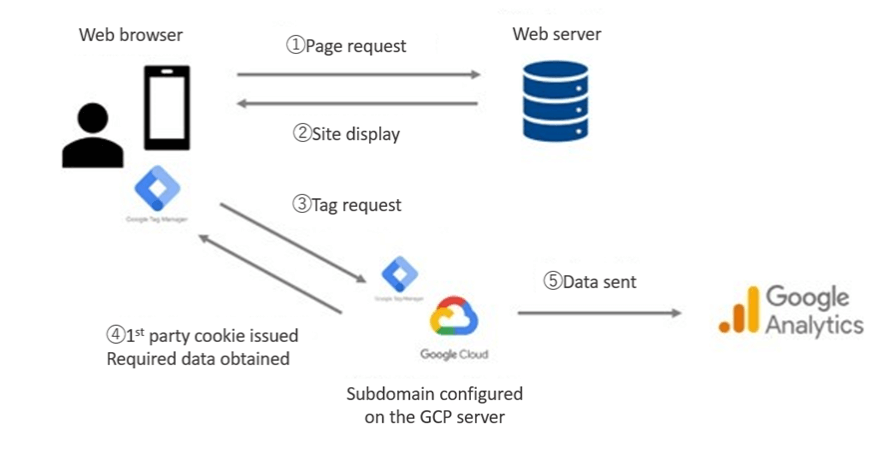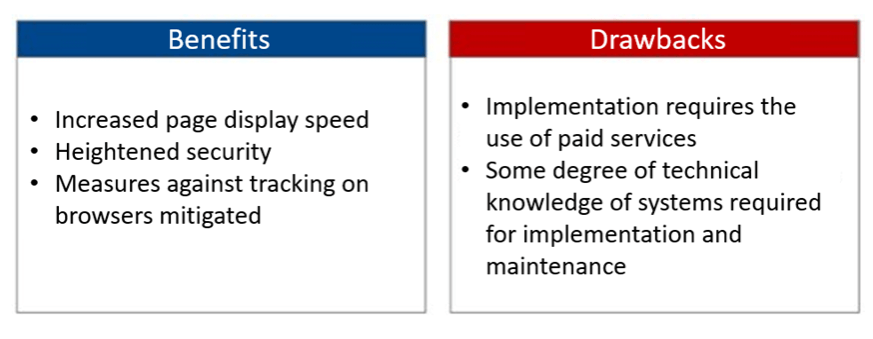In recent years, with the increasing concern for user privacy, there has been a quest to find methods for data measurement that balance both security and accuracy. This article introduces the concept of server-side tagging with Google Tag Manager (GTM), where tags are managed on the server side, addressing these concerns.
Server-side tagging setting configuration?
Server-side tagging settings on GTM is a new tag management method developed by Google. Previously, Google Tag Manager (GTM) was used to install and manage advertising tags and analytics tags on websites, with these tags firing as per configuration within GTM. Data measurement involved temporarily storing data on the browser using cookies and then sending it to servers such as Google Ads or Google Analytics.
A GTM server container is set up on virtual servers in platforms like Google Cloud Platform (GCP). This allows for the sending of measurement events to the server, enabling analysis of data on servers away from the browser and managing the sending of data to external destinations.

(Figure 1: Flowchart of GA4 data measurement using server-side tagging)
Reason for the necessity of server-side tagging
One of the primary reasons behind the development of server-side tagging is the increased scrutiny of data security on website and applications by users, as well as the strengthening of regulations on how data is handled, such as cookie use on browsers. Until now, ads and analytics taggings sent measurement data automatically to external servers. However, given the heightened scrutiny of how measurement data is managed, there was a need to develop a technology that would control the processing and transmission of data.
The benefits of configuring server-side tagging
Let’s explore 3 benefits of configuring server-side tagging settings.
1.Increased performance of websites
The first benefit is increased website performance resulting from managing various tags and processing data outside of the browser. If various tags are configured on the website’s source code, the browser will take time when it tries to process those tags, reducing the performance (display speed). Managing the required tags on GTM’s server container will reduce the amount of source code that needs to be processed, increasing the performance of the website.
2.Ensuring Security by Sending Data to In-House Management Server
The second benefit is ensuring data security by sending data to in-house management server, inaccessible to third parties. When sending data to external servers using conventional advertising or analytics tags, there’s a risk of unintended data being written and measured when tags are fired. By implementing server-side tag settings with GTM, event data is sent from the user’s device to the server, where processing for various tags takes place internally. This helps avoid sending unintended data externally or being viewed by third parties
3.The retention period of 1st Party Cookies can be configured on the server side
The third advantage is the ability to extend the retention period of 1st Party Cookies used for data measurement by mapping the subdomains of the measurement target site to the server. In environments such as Safari browsers with ITP features developed for privacy protection, traditional 3rd Party Cookies used for data measurement are immediately deleted, and the expiration period of 1st Party Cookies issued by JavaScript is set to a maximum of 7 days. With server-side tag configuration, issuing cookies from servers on the same domain as the website being measured allows for longer retention periods without being subject to ITP restrictions.
The drawbacks of server-side tag configuration
Lastly, let’s discuss the drawbacks of server-side tag configuration. To set up server-side tags, you need to utilize cloud services such as GCP. While using tools like Google Analytics or Google Tag Manager (GTM) for measurement is free of charge, there are monthly operational costs associated with maintaining servers deployed in the cloud. Additionally, apart from the usual tag implementation for measurement, managing server deployment is necessary, requiring the involvement of engineers. If another department manages the servers, you may need to collaborate internally to map subdomains to the server. Therefore, since server-side tag configuration cannot be completed solely through GTM operations, it’s essential to estimate costs beforehand.

(Figure 2: Benefits and drawbacks of configuring server-side tagging settings)
Summary
In this article, we’ve provided an overview of server-side tag configuration, including its benefits, before delving into specific implementation methods. Server-side tag configuration is a noteworthy technology for conducting precise measurements and operating marketing strategies more effectively while ensuring data security. If you’d like to learn more detailed information about the prevailing trends in privacy protection or specifics regarding implementation, please contact us.
Want to know more about Digital Marketing?
Contact us to discuss how we can work together.

Irep Inc. is an award-winning global digital marketing agency based in the San Francisco Bay Area. Our headquarters are in Tokyo and our network spans more than 20 countries. In Japan, we are ranked No. 1 for performance-based marketing. We also offer highly specialized market entry, as well as integrated marketing and localization services. Since 1997, our data-driven solutions have effectively led our diverse international clientele to continuous success in Japan, Asia, and beyond.
Irep Inc.
LinkedIn: https://www.linkedin.com/company/irepinc
Email: info@irep.inc
Address: 900 Concar Dr. Suite 400, San Mateo, California 9440



